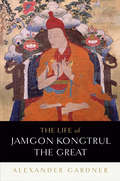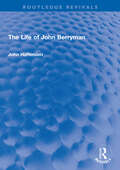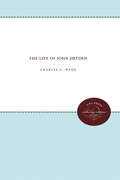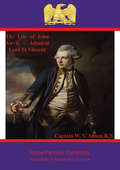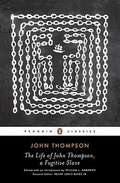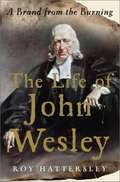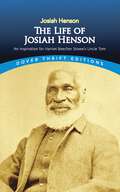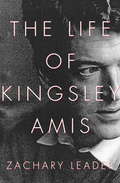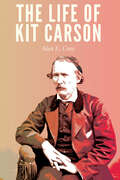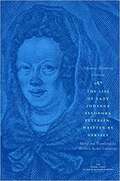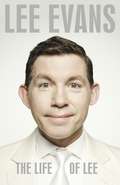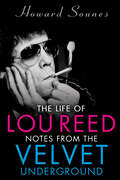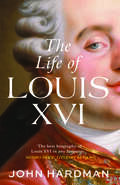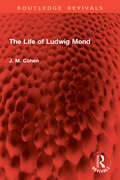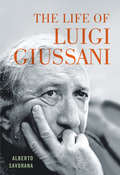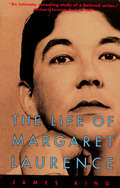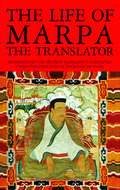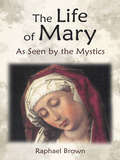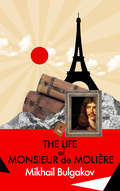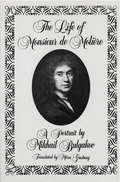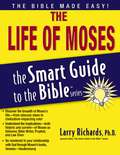- Table View
- List View
The Life of Jamgon Kongtrul the Great
by Alexander GardnerThe first-ever extensive biography of Tibet's most famous nonsectarian Buddhist lamaKnown as the “king of renunciates,” Jamgon Kongtrul Lodro Taye (1813–1899) forever changed the face of Buddhism through collecting, arranging, and disseminating the various lineage traditions of Tibet across sectarian lines. His extensive treasury collections of profound Buddhist teachings continue to be taught and transmitted throughout the Himalayas by all major traditions and represent the breadth and profundity of Tibetan Buddhist philosophy and practice. Jamgon Kongtrul was a polymath, dedicated retreatant, ritual expert, writer, and teacher from the eastern Tibetan kingdom of Derge. During the nineteenth century, while central Tibet experienced extreme sectarian divides, Jamgon Kongtrul, along with Jamyang Khyentse Wangpo and Chokgyur Lingpa, set about collecting, teaching, and transmitting the major practice traditions found in Tibet. Their activity—much of which did not adhere to the traditional divides of the Tibetan “schools” and included both tantric lineages coming from India as well as Tibetan treasure (terma) lineages—is one of the finest examples of Tibetan ecumenism, or Rimay, and Jamgon Kongtrul is perhaps the most famous among Tibet’s Rimay masters. This is the most accessible work available on Jamgon Kongtrul’s life, writings, and influence, written as a truly engaging historical biography. Alexander Gardner provides an intimate glimpse into the life of one of the most important Tibetan Buddhist teachers to have ever lived.
The Life of Jesus (DK Bibles and Bible Guides)
by Sally GrindleyDiscover the events in the life of Jesus, and how his message reached so many people.Discover facts and stories about Jesus of Nazareth, son of God, from his birth in the Bethlehem stable to his crucifixion, death, and miraculous resurrection. What was he like as a boy, how did he start to preach, and what are the meanings of his parables, such as the Good Samaritan? How did he feed five thousand and calm storms? All major events of his life are told in 26 stories, revealing how Jesus&’s message reached many people through his teaching, healing, forgiveness, and miracles. Using the Gospels of Matthew, Mark, Luke, and John as reference, this is a child-friendly introduction to the message of the Bible&’s New Testament.Engaging illustrations accompany each story, making it perfect for children to read and look at by themselves, or for reading aloud or together with parents or grandparents.
The Life of John Berryman (Routledge Revivals)
by John HaffendenFirst published in 1982, The Life of John Berryman draws on extensive research in the USA and on an enormous collection of hitherto unpublished materials – journals, letters, stories and poetry –to build a biography that recounts in absorbing detail the public and private stages of John Berry man’s career. It also offers an intimate portrait of a creative artist: his compulsive self-presentation and self-reproach, his moral and artistic dilemmas, his dedication and his accomplishments. John Berryman occupies a central place among the outstanding poets of recent times. The course of his life ran between the extremes of personal degradation and artistic ecstasy. He suffered the early suicide of his father, the dominance of his mother, poverty and professional setbacks, psychiatric treatment, alcoholism, and sexual and spiritual vexation. He became an electrifying, fearful teacher and a loving, jealous friend. His mentors and close associates included Mark Van Doren, Richard Blackmur, Allen Tate, Robert Lowell and Saul Bellow. The years brought him spells of deep personal joy and artistic fulfilment, but all too heavy a hand of terrible suffering. The book will be an extremely interesting read for students of literature.
The Life of John Dryden
by Charles E. WardThis book fills the need for a complete, accurate, and impartial reexamination of Dryden's life and career as poet, dramatist, and man of letters. By examining the numerous autobiographical passages that Dryden inserted in his writings and by interpreting these in the light of Dryden's relationships with persons and contemporary situations, the author disproves some long-accepted explanations of Dryden's conduct.Originally published in 1961.A UNC Press Enduring Edition -- UNC Press Enduring Editions use the latest in digital technology to make available again books from our distinguished backlist that were previously out of print. These editions are published unaltered from the original, and are presented in affordable paperback formats, bringing readers both historical and cultural value.
The Life of John Jervis – Admiral Lord St Vincent
by Captain W. V. Anson R.N.This ebook is purpose built and is proof-read and re-type set from the original to provide an outstanding experience of reflowing text for an ebook reader. Amongst the heroic figures of the Royal Navy of the Revolutionary and Napoleonic wars; Admiral Nelson stands out from a number of great men. Without Lord St. Vincent, it is difficult to imagine how Horatio Nelson would have been afforded the latitude he needed for his victories. Before Nelson flew his pennant in the Victory, Sir John Jervis would lead that ship and his squadron, of which Nelson was a conspicuous part, to huge success at the battle of Cape St. Vincent that would earn Jervis his earldom. John Jervis ran away to join the Navy at the tender age of 13. After much time spent on board ships in the Caribbean, he worked his way up the ladder of promotion - from seaman to first lieutenant - before he was assigned to the expedition under General Wolfe to Canada, during which he impressed all with his conduct. At the outbreak of the wars with France, Sir John Jervis was a vice-admiral of long service and huge experience, his various postings around the fleet - along with his crowning achievement at the battle of St. Vincent - all captured in this biography. Although greatly outnumbered, his determination to bring the enemy to battle was the foundation of the aggressive self-confidence carried by the Royal Navy for many years to come. Stern disciplinarian when confronted by mutiny in the fleet, he nevertheless had a softer side which was indulged when he saw a deserving case of a man in dire straits. On his elevation to the post of First Lord of the Admiralty, his determination to improve the efficiency of the Navy and the lot of the common sailor gained him a great reputation among the Navy of the day. A first-rate biography. Author - Captain W. V. Anson R.N. (1855 - ????) Text taken, whole and complete, from the edition published in 1913, London, by John Murray. Original - viii and 359 pages. Illustrations - 10 portraits and 4 battle plans. Title - The Life of John Jervis - Admiral Lord St Vincent
The Life of John Thompson, a Fugitive Slave
by John ThompsonThe unique narrative of a slave who fled to freedom and sailed aboard a whaling vessel. John Thompson was born into slavery on a Maryland plantation in 1812. Originally published in 1856, The Life of John Thompson, a Fugitive Slave chronicles his enslavement, his escape, and his life in the North, where he lived as a free man until fear of recapture drove him to flee once again-this time to sea aboard the Milwood, a whaling vessel. The only fugitive slave narrator to report a whaling voyage, Thompson crafted from his seafaring experience an allegorical sermon that caps his Life and renders it a kind of African American Pilgrim's Progress, as well as a narrative of struggle with, escape from, and triumph over American slavery. .
The Life of John Wesley: A Brand from the Burning
by Roy HattersleyThe Life of John Wesley portrays the founder of Methodism against a vividly rendered backdrop of the religious, social, and political landscape of eighteenth-century England. Through the power of his personality and the strength of his faith, Wesley became the leader of the English religious revival that arose in opposition to the established Anglican Church, and his theology continues to have an impact on religions worldwide. Roy Hattersley follows Wesley’s spiritual journey, tracing his constant, often agonizing attempts to define the nature of virtue as well as the path to sanctity. The story of Wesley’s theological progress is vastly enriched by Hattersley’s revealing portrait of Wesley’s complex personality. A genuine scholar, Wesley published more work than any other author of the eighteenth century. He possessed phenomenal energy, traveling huge distances to preach and proselytize. Wesley practiced, as Hattersley writes, “every form of personal discipline (diet, exercise, carefully planned day) except emotional restraint.” This candid account of Wesley’s relationship with women—falling desperately in love three times in his life, each time failing to make his intentions clear, and eventually ending up in a disastrous marriage—brilliantly brings to life Wesley’s human side, largely ignored in previous reverential biographies. A wonderful synthesis of personal, social, and spiritual biography, The Life of John Wesley sheds new light on the variety of things that motivated one of the most interesting and significant figures in religious history.
The Life of Josiah Henson: An Inspiration for Harriet Beecher Stowe's Uncle Tom (Travel In America Series)
by Josiah HensonBorn into slavery on a Maryland farm, Josiah Henson (1789–1883) worked as a foreman, married, and became a preacher in the Methodist Episcopal Church. Faced with the prospect of separation from his family, Henson fled with his wife and children to Ontario, where he became a leader in the Afro-Canadian community. The Life of Josiah Henson, Formerly a Slave, Now an Inhabitant of Canada, as Narrated by Himself first appeared in 1849. The book's avid readers included Harriet Beecher Stowe, who later acknowledged its influence on her own masterwork, Uncle Tom's Cabin.Henson's narrative recounts the circumstances of his bondage, his conversion to Christianity, and his fruitless attempts to buy his freedom. Risking starvation, exposure, and recapture, the Henson family walked from Kentucky to Ohio. Native Americans assisted the struggling family, as did sympathetic boatmen who ferried them across Lake Erie. Safely established as a tenant farmer and clergyman in a new country, Henson took an active role in organizing a self-sufficient community. His memoirs helped alert his contemporaries to the horrors and heartbreak of slavery, and they offer modern readers an authentic account of one family's triumph over injustice and inhumanity.
The Life of Kingsley Amis
by Zachary LeaderThis comprehensive biography of British comic novelist Kingsley Amis (1922-1995) draws on interviews with those who knew him, his fiction and poetry, memoirs, and letters to describe his life. Leader (English literature, U. of Roehampton, UK) uses six themes to construct the narrative: the influence of his early upbringing, aggression in his character and writings, his energy, his sense of writing as craft or profession, his issues with distinctions between high and low culture and love of popular forms, and his obsession with egotism, selfishness, and inconsiderateness. He also discusses his writing methods and the relationship of his writings to his contemporaries. Annotation ©2007 Book News, Inc. , Portland, OR (booknews. com)
The Life of Kit Carson
by Alan E. GreyKit Carson, the quintessential frontiersman, is remembered as a larger-than-life mountain man, explorer, trapper, guide, soldier, Indian agent, officer, hunter, and rancher. In The Life of Kit Carson, Alan E. Grey invites young readers to join Kit as he strikes out on his own at the age of sixteen to find adventure along the beaver streams; ride with him and John Fremont as they explore the untamed West, taking cover as Kit trades gunfire in the Mexican-American War; and witness his encounters with Indians in the Navajo and Southern Plains campaigns. Composed of stories discovered through years of research, this book is an exciting and easy-to-read, action-packed tale. Young readers and adults alike will find both education and entertainment in this masterfully presented life story.
The Life of Lady Johanna Eleonora Petersen, Written by Herself: Pietism and Women's Autobiography in Seventeenth-Century Germany (The Other Voice in Early Modern Europe)
by Johanna Eleonora Petersen Barbara Becker-CantarinoIn a time when the Pauline dictum decreed that women be silent in matters of the Church, Johanna Eleonora Petersen (1644–1724) was a pioneering author of religious books, insisting on her right to speak out as a believer above her male counterparts. <p><p> Publishing her readings of the Gospels and the Book of Revelation as well as her thoughts on theology in general, Petersen and her writings created controversy, especially in orthodox circles, and she became a voice for the radical Pietists—those most at odds with Lutheran ministers and their teachings. But she defended her lay religious calling and ultimately printed fourteen original works, including her autobiography, the first of its kind written by a woman in Germany—all in an age in which most women were unable to read or write. <p><p> Collected in The Life of Lady Johanna Eleonora Petersen are Petersen's autobiography and two shorter tracts that would become models of Pietistic devotional writing. A record of the status and contribution of women in the early Protestant church, this collection will be indispensable reading for scholars of seventeenth-century German religious and social history.
The Life of Langston Hughes: 1941-1967
by Arnold RampersadVolume II catches up with Hughes in Harlem, the Harlem Renaissance and his relationships with other writers, including Richard Wright, Ralph Ellison, James Baldwin and Amiri Baraka.
The Life of Lee
by Lee EvansLee Evans is one of the best-loved comedians in the country; a Hollywood star able to sell out arenas in the blink of eye. But he was not always such a roaring success. The Life of Lee is an utterly hilarious and very moving autobiography charting his ups and downs on the way to the top. Lee takes us on a darkly humorous journey through his childhood spent running wild on a Bristol housing estate and his unconventional school days, when he was publicly derided as 'a failure' by a sadistic teacher. In this brilliantly entertaining and engaging tale, he also guides us through a grim teenage period of numerous dead-end jobs. When he was cleaning toilets and plucking turkeys, he could never have imagined that one day he would be playing to thousands of adoring fans at the O2 Arena. The book also reveals how as a boy Lee got his first taste of showbiz, living out of a suitcase and accompanying his entertainer father around the smoky, rowdy, unforgiving working-men's club and theatre circuit. Desperately struggling to be accepted, this quiet young loner always saw himself as an outsider. But he finally met the love of his life and accidentally discovered the one place where he felt at home: the stage. The Life of Lee is a story that is like its subject: compelling, touching, charming and, above all, fantastically funny.
The Life of Lou Reed: Notes from the Velvet Underground
by Howard SounesAn illuminating biography of Lou Reed, featuring interviews with over 140 people who knew him intimately, plus previously unpublished photographs. As band leader of the Velvet Underground and later a successful solo artist, Reed was much more than what the general public came to know as the grumpy New Yorker in black who sang &“Walk on the Wild Side.&” To his dedicated admirers, he was one of the most innovative and intelligent songwriters of modern times—a natural outsider who lived a tumultuous and tortured life. In the course of his deep research into Reed&’s life, from a humble upbringing on Long Island to death from liver disease in 2013, Howard Sounes interviewed more than 140 people who knew the artist intimately—some of whom have not spoken publicly about him before. With new revelations from former wives and lovers, family members, fellow band members and celebrities, and music industry figures, this book offers an updated, unfettered look at Reed&’s creative process, his mental health problems, his bisexuality, his three marriages, and his addictions to drugs and alcohol. Featuring previously unpublished photographs of some of Reed&’s most private moments, this is the definitive account of one of rock &’n&’ roll&’s most complicated and brilliant prophets. &“Compelling . . . Sounes takes pride in carefully debunking the myths that have crept in from Reed&’s own fictionalizations.&” —The Sunday Telegraph &“Controversial . . . Sounes&’ book pushes the standard Reed narrative.&” —New York Times &“A measured chronicle of the life and music of Lou Reed . . . Sounes proves to be an amiable narrator who successfully reveals Reed as an innovative, influential musician.&” —Publishers Weekly &“A walk on the dark side.&” —Independent &“A must read . . . Sounes chronicles Reed&’s turbulent, and often brutal, relationships with men and women . . . and the wayward talent that produced such classics as &‘Walk On The Wild Side.&’&” —Daily Mail
The Life of Louis XVI
by John HardmanA thought-provoking, authoritative biography of one of history’s most maligned rulers: France’s Louis XVI “The definitive contribution to our understanding of Louis XVI as a man and a monarch.”—P. M. Jones, English Historical Review “Monumental. . . . Scholars probing the mysteries of the late Old Regime and French Revolution will be working in its shadow for many years to come.”—Thomas E. Kaiser, Journal of Modern History Louis XVI of France, who was guillotined in 1793 during the Revolution and Reign of Terror, is commonly portrayed in fiction and film either as a weak and stupid despot in thrall to his beautiful, shallow wife, Marie Antoinette, or as a cruel and treasonous tyrant. Historian John Hardman disputes both these versions in a fascinating new biography of the ill-fated monarch. Based in part on new scholarship that has emerged over the past two decades, Hardman’s illuminating study describes a highly educated ruler who, though indecisive, possessed sharp political insight and a talent for foreign policy; who often saw the dangers ahead but could not or would not prevent them; and whose great misfortune was to be caught in the violent center of a major turning point in history. Hardman’s dramatic reassessment of the reign of Louis XVI sheds a bold new light on the man, his actions, his world, and his policies, including the king’s support for America’s War of Independence, the intricate workings of his court, the disastrous Diamond Necklace Affair, and Louis’s famous dash to Varennes.
The Life of Ludwig Mond (Routledge Revivals)
by J. M. CohenFirst published in 1956, The Life of Ludwig Mond is one of the earliest biographies to present the story of Dr. Mond. The book, as a biography, is mainly and rightly concerned with the man himself, but it could hardly avoid dealing with the growth of those parts of the heavy chemical industry with which Ludwig Mond was associated. Quite apart from the clearly drawn portrait it provides, the book adds a most useful and interesting chapter to the history of one of the main branches of the early chemical industry. It throws light on the progressive changes that have taken place in chemical knowledge, in methods of manufacture, in the size of firms, and in industrial relations, in which Ludwig Mond was a pioneer. This important historical work is valuable to those interested in the life of Ludwig Mond as well as the development of industrial philosophy.
The Life of Luigi Giussani
by Alberto Savorana Chris Bacich Mariangela Sullivan<p>Monsignor Luigi Giussani (1922–2005) was the founder of the Catholic lay movement Communion and Liberation in Italy, which has hundreds of thousands of adherents around the globe. In The Life of Luigi Giussani Alberto Savorana, who spent an important part of his life working and studying with Giussani, draws on many unpublished documents to recount who the priest was and how he lived. Giussani’s life story is particularly significant because it shares many of the same challenges, risks, and paths toward enlightenment that are described in his numerous and influential publications. <p>Savorana demonstrates that the circumstances Giussani experienced and the people he encountered played a crucial role in defining his vocation. Illuminating details are shared about Giussani’s parents, professors, and friends in the seminary, the things he read, his priesthood, his experience teaching, misunderstandings and moments of recognition, and illness. Luigi Giussani considered Christianity to be a fact, a real event in human life, which takes the form of an encounter, inviting anyone and everyone to verify its relevance to life’s needs. This is what happened for so many people all over the world who recognized in this priest and leader, with his rough and captivating voice, not only a teacher to learn from, but above all a man to compare oneself with – a companion for the journey who could be trusted to answer the question: how can we live? <p>In addition to providing the first chronological reconstruction of the life of the founder of Communion and Liberation, The Life of Luigi Giussani provides a detailed account of his legacy and what his life’s work meant to individual people and the Church.</p>
The Life of Madie Hall Xuma: Black Women's Global Activism during Jim Crow and Apartheid (Women, Gender, and Sexuality in American History)
by Wanda A. HendricksRevered in South Africa as "An African American Mother of the Nation," Madie Beatrice Hall Xuma spent her extraordinary life immersed in global women's activism. Wanda A. Hendricks's biography follows Hall Xuma from her upbringing in the Jim Crow South to her leadership role in the African National Congress (ANC) and beyond. Hall Xuma was already known for her social welfare work when she married South African physician and ANC activist Alfred Bitini Xuma. Becoming president of the ANC Women’s League put Hall Xuma at the forefront of fighting racial discrimination as South Africa moved toward apartheid. Hendricks provides the long-overlooked context for the events that undergirded Hall Xuma’s life and work. As she shows, a confluence of history, ideas, and organizations both shaped Hall Xuma and centered her in the histories of Black women and women’s activism, and of South Africa and the United States.
The Life of Margaret Laurence
by James KingThe magnificent and long-awaited biography of the beloved writer who gave us the Manawaka novels, including The Diviners and The Stone Angel.
The Life of Marpa the Translator: Seeing Accomplishes All
by Tsangnyon Heruka Chogyam Trungpa Nalanda Translation CommitteeMarpa the Translator, the eleventh-century farmer, scholar, and teacher, is one of the most renowned saints in Tibetan Buddhist history. In the West, Marpa is best known through his teacher, the Indian yogin Nâropa, and through his closest disciple, Milarepa. This lucid and moving translation of a text composed by the author of The Life of Milarepa and The Hundred Thousand Songs of Milarepa documents the fascinating life of Marpa, who, unlike many other Tibetan masters, was a layman, a skillful businessman who raised a family while training his disciples.As a youth, Marpa was inspired to travel to India to study the Buddhist teachings, for at that time in Tibet, Buddhism had waned considerably through ruthless suppression by an evil king. The author paints a vivid picture of Marpa's three journeys to India: precarious mountain passes, desolate plains teeming with bandits, greedy customs-tax collectors. Marpa endured many hardships, but nothing to compare with the trials that ensued with his guru Nâropa and other teachers. Yet Marpa succeeded in mastering the tantric teachings, translating and bringing them to Tibet, and establishing the Practice Lineage of the Kagyüs, which continues to this day.
The Life of Mary: As Seen by the Mystics
by Mary Of Agreda Anne Catherine Emmerich Raphael Brown James TissotGenerations of devout Catholics, including many learned theologians and writers, have derived great spiritual benefits from a careful reading of the private revelations here compiled, those of Ven. Anne Catherine Emmerich and Ven. Mary of Agreda, primarily, along with those of St. Bridget of Sweden and St. Elizabeth of Schoenau. From the birth of Mary to her Coronation in Heaven, this book provides the reader with remarkable insights into the life of Our Lady, and an unmatched depth of understanding of the Holy Family. What is also shown with utmost clarity is that Mary is a model of the interior life, and an example of perfect submission to the will of God. "As we read," writes Dom Prosper Gueranger, "our heart slowly takes fire, our soul feels desires for virtue which it had not hitherto experienced, the mysteries of faith appear more luminous to us, bit by bit the world and its hopes vanish, and the longing for the good things of Heaven, which seemed to have been dozing within us, awakens with new fervor."
The Life of Milarepa
by Lobsang P. LhalungpaTo the people of Tibet and to fellow Buddhists in the Asian highlands and the Himalayas, Mila, although he lived in the twelfth century, is not a myth but still a vital figure - the embodiment of supreme excellence as well as the father of awakened masters. Never, in the thirteen centuries of Buddhist history in Tibet, has there been such a man, who not only inspired an intellectual elite and spiritual luminaries, but also captured the imagination of the common people.
The Life of Monsieur de Molière
by Mikhail BulgakovBlending biography with fiction, this portrait of the famed French playwright is written by a kindred spirit: the author of The Master and Margarita. Mikhail Bulgakov and Jean-Baptiste Poquelin—more commonly known as Molière—had much in common. The twentieth-century Russian satirist and dramatist and the seventeenth-century French playwright known for Tartuffe and The Misanthrope shared a love for finding material in the shortcomings and follies of the human condition. They both created their art under unpredictable and often repressive regimes—Bulgakov under the Bolsheviks and Molière under King Louis XIV—and often saw their work censored or banned. Both were also favored by influential men: King Louis was Molière&’s patron, and Stalin, despite his oppressive rule, was a fan of Bulgakov&’s work. Perhaps it is not surprising that Bulgakov penned such a vibrant, affectionate biography of one of the greatest masters of comedy in the Western canon. Written between 1932 and 1933 and eventually published posthumously in 1963, Bulgakov&’s portrait of the famed French playwright and actor goes beyond the usual boundaries of biography—the two men at times seem to be communicating with each other across the centuries through Bulgakov&’s lively prose and inspired interpretations of the life of a literary kindred spirit. Sliding delightfully between fiction and meticulous fact, The Life of Monsieur de Molière is not to be missed. &“In its playfulness and hybridity, this book looks forward to contemporary 'faction' that fuses fiction and biography.&” —John Dugdale, The Guardian Book Review
The Life of Monsieur de Molière: A Portrait by Mikhail Bulgakov
by Mirra Ginsburg Mikhail Afanasevich BulgakovThis portrait of Moliere, by Mikhail Bulgakov, goes far beyond mere biography. The Russian master brings a kindred spirit vividly to life in this novelistic story of art and the struggle it demands. Mikhail Bulgakov’s The Life of Monsieur de Moliere is a fascinating portrait of the great French seventeenth-century satirist by one of the great Russian satirists of our own century. For Bulgakov, Moliere was an alter ego whose destiny seemed to parallel his own. As Bulgakov’s translator, Mirra Ginsburg, informs us: "There is much besides their craft that links these two men across the centuries. Both had a sharp satirical eye and an infinite capacity for capturing the absurd and the comic, the mean and the grotesque: both had to live and write under autocracies: both were fearless and uncompromising in speaking of what they saw, evoking storms with each new work: and shared what Bulgakov calls ’the incurable disease of passion for the theater.’ The life of Moliere, born Jean-Baptiste Poquelin, is a story of struggle and dedication, and Bulgakov tells it with warmth and compassion. Indeed, for all Bulgakov’s careful attention to historical detail, his vivid recreation of seventeenth-century France makes The Life of Monsieur de Moliereread more like a novel than a formal biography. Mikhail Bulgakov (1891-1949) is best known in the West for his monumental novel The Master and Margarita. His The Life of Monsieur de Moliere, completed in 1933, was not published until 1962. Mirra Ginsburg’s translation of this neglected masterpiece will find a welcome readership among devotees of the theater and of modern Russian literature.
The Life of Moses (The Smart Guide to the Bible Series)
by Larry RichardsFew people have had a greater impact on our lives-and our concept of God-than Moses.His unlikely start in life was guided by God, as was his mission to deliver Israel from bondage. During that mission, Moses wrote the first five books of the Old Testament, became Israel's first and greatest prophet, and gave to them the Ten Commandments and the law that Jews still follow today.Features include:How to be smart about the power of Moses's mission and relationship with God Moses's impact on the church and current events Understanding events from Genesis through Deuteronomy God's calling and equipping
